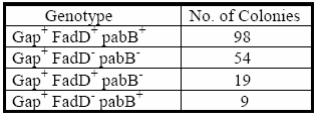Solution-What is map distance between the loci
1. Humans have 46 chromosomes whereas chimpanzees, gorillas, and orangutans have 48. These apes possess two pairs of acrocentric chromosomes that are not present in humans but that are morphologically very similar to the long and short arms of the large submetacentric human chromosome 2. Suggest a mechanism that could account for the different chromosome numbers present in humans and apes.
2. An individual with Turner’s syndrome and afflicted with the X-linked recessive trait nystagmus is produced by parents that are both phenotypically normal. The individual has a brother that is also afflicted with nystagmus and a brother that is phenotypically normal. Is it the paternal or maternal X that is missing in the Turner’s syndrome female? How do you know?
3. How many chromosomes would be found in somatic cells of an allotetraploid derived from two plants, one with N=7 and the other with N = 10?
4. If a normal diploid cell possessed 24 chromosomes, what is the chromosome content (number) of the following:
A. Nullisomic ________
B. Monosomic ________
C. Tetrasomic ________
D. Triploid ________
E. Tetraploid ________
5. A mating between his+, leu+, thr+, pro+, strs cells (Hfr) and his-, leu-, thr-, pro-, strr cells (F-) is allowed to continue for twenty-five minutes. The mating is stopped and the genotypes of the recombinants determined. What is the first gene to enter and what is the probable gene order?

6. The DNA from a prototrophic strain of E. coli is isolated and used to transform an auxotrophic strain deficient in the synthesis of purines (purB-) and pyrimidines (pyrC-).
![]()
A. What is map distance between the loci?
B. Calculate the co-occurrence (cotransfer) index (r).
7. A woman in her mid-twenties has a Down syndrome child. She is told by her misinformed physician that she should not worry too much about having another child, since the chance of the child having Down syndrome would be no greater than the average frequency of 1 in 1500 for pregnant women of her age. Why might the physician by incorrect? What test should be done on the parents before advising the woman?
8. In three different interrupted mating experiments, you obtain the following data for the time of entry of the following genes: arg, met, leu, ser, gal, val, and phe. All of these experiments were conducted using Hfr strains (Hfr 1, Hfr 2, and Hfr 3) derived from the same original strain of E. coli.

Determine the order of these genes on the bacterial chromosome and draw a single map showing the position of each of these genes on the bacterial chromosome. Based on the time intervals above, indicate the map distances between each gene, expressedin minutes. Also show the origin of transfer and direction of transfer for each Hfr.
9. P1 transduction was done to determine the order of the fadD, gap, and pabB genes relative to each other. The donor was fadD-gap+ pabB- and the recipient was fadD+ gap- pabB+. Gap+ transductants were selected. The coinheritance of the nonselected markers are shown in the table below.

A. Calculate the cotransduction frequencies.
B. Assume the average length of the transducing DNA (L) is 1.8 minutes and calculate the map distance (d) between the loci.
C. Construct a linkage map showing the order of the genes and map distances between them
